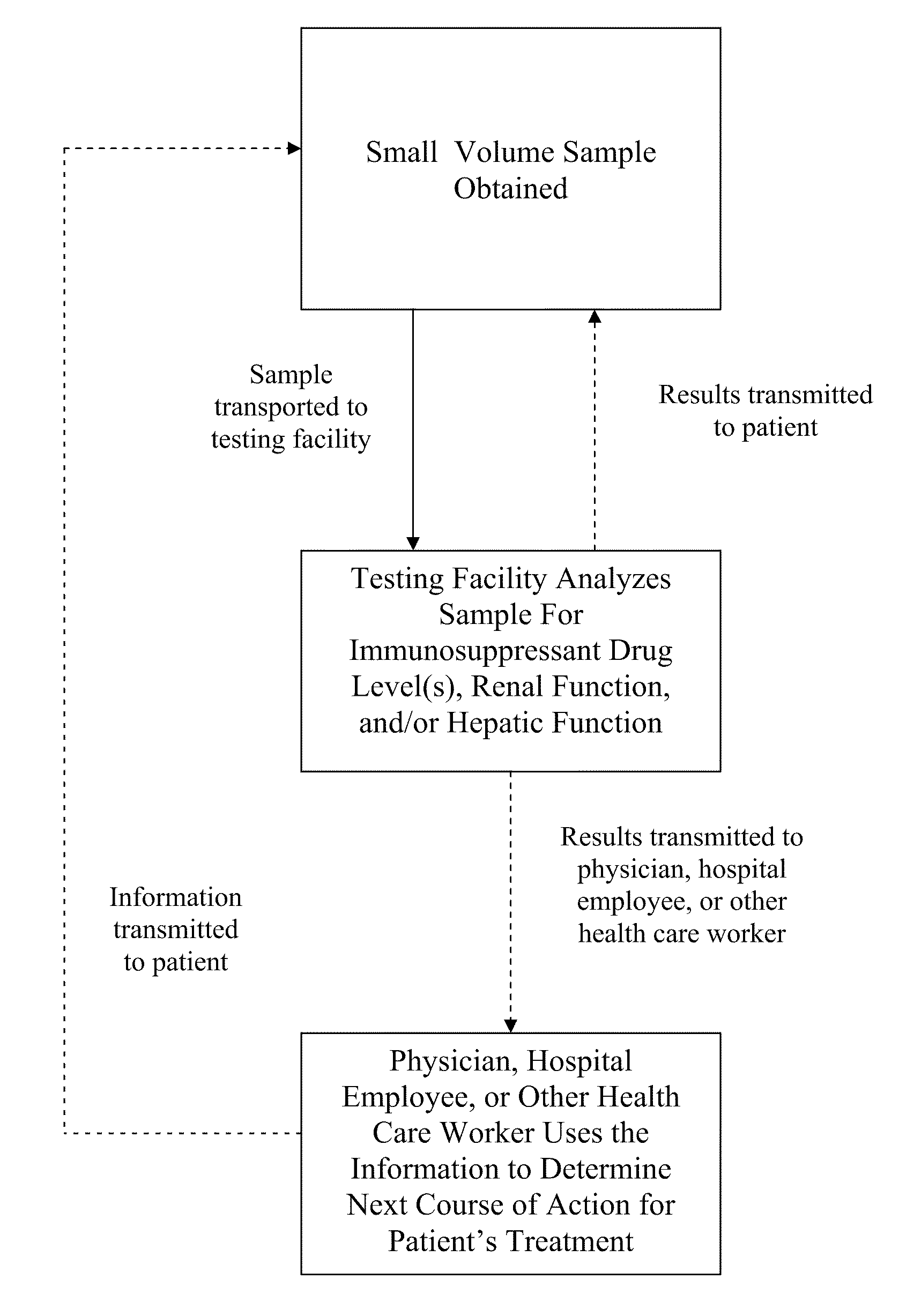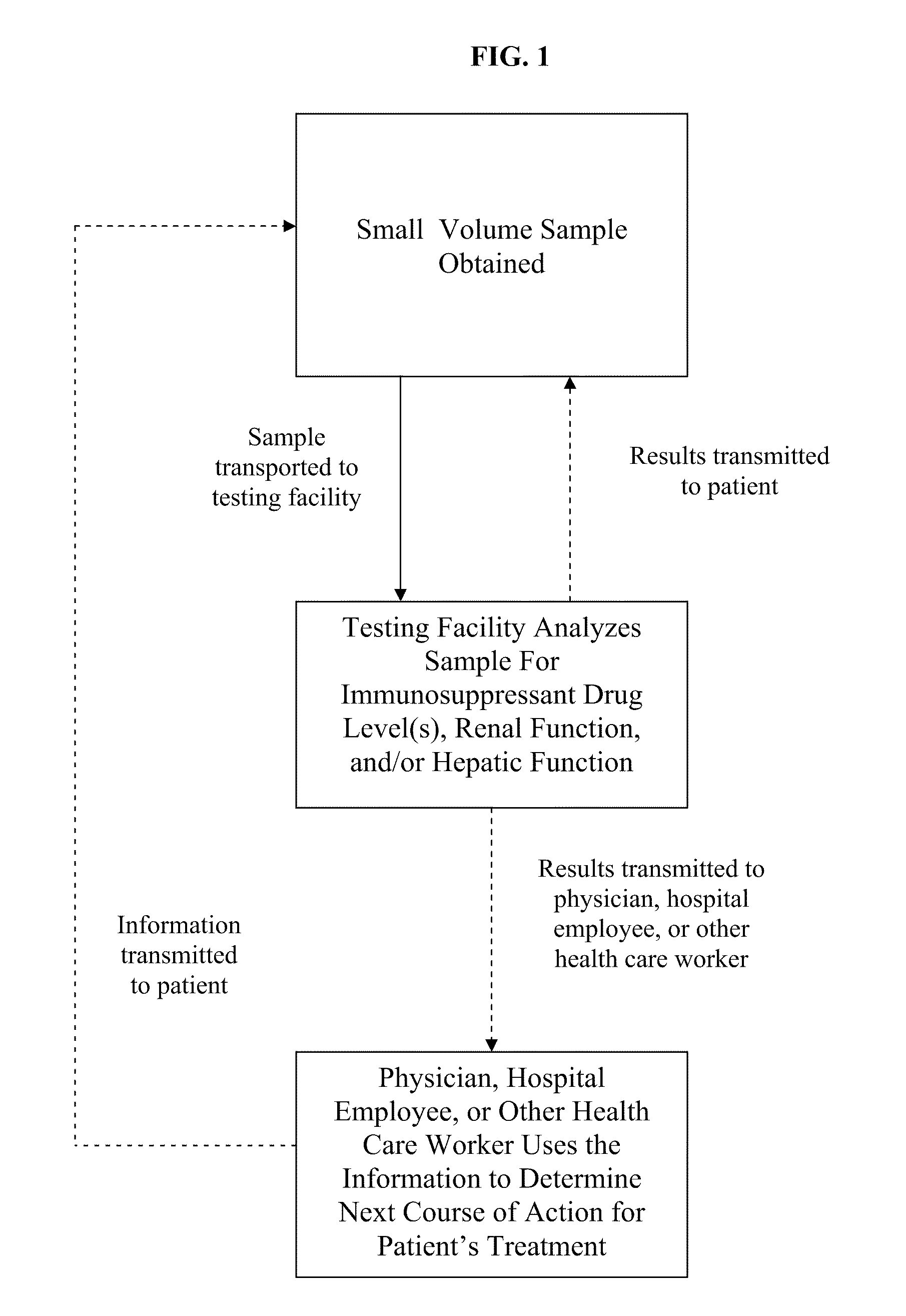Methods for Monitoring Immunosuppressant Drug Levels, Renal Function, and Hepatic Function Using Small Volume Samples
a technology of immunosuppression drug and sample, which is applied in the field of small sample sample methods for monitoring immunosuppressive drug levels, renal function, and hepatic function, can solve the problems of body's overreaction to what would otherwise be harmless matter, acute rejection episodes, and even death
- Summary
- Abstract
- Description
- Claims
- Application Information
AI Technical Summary
Benefits of technology
Problems solved by technology
Method used
Image
Examples
example 1
[0040]Preparation of Small Volume Blood Sample from Fingerstick
[0041]A small volume blood sample is collected using the HOMETRAK (TMS Biosciences, New Orleans, La.) blood collection kit. The patient's hands are washed and then the desired area is cleaned with an alcohol swab, letting the area air dry for about 10 seconds. A lancet is used to puncture the patient's skin in the cleaned area, and then blood drops are collected in the blood collection tube (i.e., K2EDTA collection tube, optionally with a preservative agent), using the lip of the tube to collect the blood drops as they form. The collection tube is rocked or tapped gently or pushed downward to allow the blood drops to settle in the bottom of the tube with the anti-clotting agent. Once the desired amount of blood sample is collected (e.g., approximately 500 μL), the collection tube is sealed and rotated end over end several times to ensure the blood is properly mixed with the anti-clotting agent and preservative agent. The...
example 2
Therapeutic Drug Monitoring of Immunosuppressants (TDM-IDS) in a Small Volume Blood Sample
Sirolimus Levels
[0043]Sirolimus levels are measured using LC-MS / MS (Tandem Mass Spectrometry) or high performance liquid chromatography coupled to electro-spray ionization tandem mass spectrometry (HPLC-ESI-MS / MS) under standard conditions known in the art, and results of this testing are available to the patient or healthcare provider usually within twenty-four hours of receipt of the sample.
[0044]The testing facility provides reference lab service for the immunosuppressant drug monitoring of Rapamycin (Sirolimus, RAPAMUNE®—Wyeth) for transplant programs. The facility utilizes high performance liquid chromatography coupled to electro-spray ionization tandem mass spectrometry (HPLC-ESI-MS / MS or LC-MS / MS) as the definitive quantitative method to accurately determine blood levels of rapamycin. Tandem mass spectrometry has been demonstrated in numerous studies to be the method of choice for immuno...
example 3
[0054]Analysis of Renal and / or Hepatic Function Using a Small Volume Blood Sample
[0055]The renal function and / or hepatic function of a patient is determined using a small volume blood sample. Blood samples from adult patients are collected in a 3 mL EDTA collection tube, K2EDTA collection tube, or lithium-heparin collection tube as described above. Pediatric patient blood samples may be collected in 0.2 mL EDTA microtubes. Suitable samples for the described methods have been stored at ambient temperature for about twenty-four hours or less, at about 4° C. for seven days or less, or at −20° C. for up to three months. Temperature stability studies are performed to determine stability of each analyte at various environmental temperatures for various lengths of time to establish criteria for rejection of samples. Generally, samples that are clotted, have inadequate volume, plasma, serum, or that have been at ambient temperature for greater than about twenty-four hours in the absence of ...
PUM
| Property | Measurement | Unit |
|---|---|---|
| volume | aaaaa | aaaaa |
| volume | aaaaa | aaaaa |
| volume | aaaaa | aaaaa |
Abstract
Description
Claims
Application Information
 Login to View More
Login to View More - R&D
- Intellectual Property
- Life Sciences
- Materials
- Tech Scout
- Unparalleled Data Quality
- Higher Quality Content
- 60% Fewer Hallucinations
Browse by: Latest US Patents, China's latest patents, Technical Efficacy Thesaurus, Application Domain, Technology Topic, Popular Technical Reports.
© 2025 PatSnap. All rights reserved.Legal|Privacy policy|Modern Slavery Act Transparency Statement|Sitemap|About US| Contact US: help@patsnap.com



